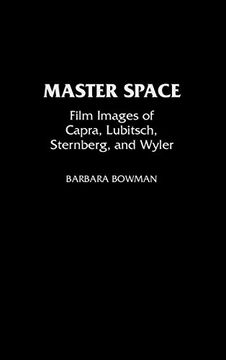Compartir
Master Space: Film Images of Capra, Lubitsch, Sternberg, and Wyler (en Inglés)
Barbara Bowman (Autor)
·
Praeger
· Tapa Dura
Master Space: Film Images of Capra, Lubitsch, Sternberg, and Wyler (en Inglés) - Barbara Bowman
$ 265.594
$ 531.188
Ahorras: $ 265.594
Elige la lista en la que quieres agregar tu producto o crea una nueva lista
✓ Producto agregado correctamente a la lista de deseos.
Ir a Mis Listas
Origen: Estados Unidos
(Costos de importación incluídos en el precio)
Se enviará desde nuestra bodega entre el
Martes 18 de Junio y el
Martes 02 de Julio.
Lo recibirás en cualquier lugar de Colombia entre 1 y 5 días hábiles luego del envío.
Reseña del libro "Master Space: Film Images of Capra, Lubitsch, Sternberg, and Wyler (en Inglés)"
This is a unique study of the use of cinematic space by four important directors in American cinema from the 1930s to the 1960s: Frank Capra, Ernst Lubitsch, Josef von Sternberg, and William Wyler. Barbara Bowman examines each of their distinctive styles and diverse backgrounds and shows how these unique visual styles complement each other--representing the best in classic American cinema, from Ninotchka and Shanghai Express to Best Years of Our Lives to It's a Wonderful Life.These great directors viewed space not as simple emptiness, nor as something to be manipulated pragmatically, but as a frame or palette in which to work. Their arrangements of cinematic space become not just visually recurrent techniques, but aesthetic touchstones that alert spectators to the narrative shape of the film and invite the spectator to have a more self-conscious relation to the film. Bowman explains how Capra's challenge was to take what is spatially familiar, like James Stewart's or Gary Cooper's neighborhood or small town, and defamiliarize it enough so that we see it for the first time. Lubitsch's creation of film space relies on the indirection so apparent in his scripts by Samuel Raphaelson; he depends on what the spectator cannot yet see or only anticipates, relying upon our imaginations, especially our potential lasciviousness. Sternberg's veiled shots of Marlene Dietrich and others convey a very basic skepticism about human capacity for both sight and insight, and Wyler emotionalizes his films's space by having characters like Bette Davis confront each other in triangular groups or by double framing his figures with architectural second frames. Each director approached film space with his own singular style, but all four techniques shared a common purpose to explain characters or to teach the spectator to see more intensely.

